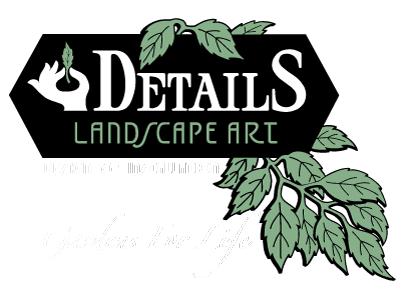Birdhouses provide two of the four basic needs of birds – shelter and nesting sites. As discussed in a previous blog, birds need shelter from the elements and from predators, and must have locations and habitats for breeding.
Details Landscape Art designs and builds beautiful gardens for a variety of clients, many of whom are bird lovers. For these folks we install plants and trees that attract birds, and homeowners may supplement the flowers and seeds from this plant material by setting out birdfeeders (September 10, 2018 blog). Now that we have provided food to attract birds, we must provide a safe haven and a nesting site for them.
And nesting sites are very bird specific. Certain species only nest in shrubs, others only on tree branches, still others only on the ground. Birds that only nest in tree cavities are the ones that will use birdhouses. Birds that nest in tree cavities depend on holes in existing trees for their homes. As we cut down trees for lumber and to make space for new development, natural habitats for these birds disappear; birdhouses supplement this housing shortage. Birds that LOVE birdhouses include wrens, tree swallows, titmice, bluebirds, chickadees and nuthatches.
Different bird species prefer different locations and habitats. Determine if there are already certain species that visit the garden, and locate one or more birdhouses in sites that appeal to the existing birds. Then locate houses to attract birds that are not current residents. Be sure to make sure the houses are installed as far away from the house or from the road as possible. People activity can scare away birds from feeding or nesting. The birdhouse should be at least several feet off the ground, but not so high that people can’t reach them to clean them out occasionally.
The real estate market for birds is as varied as it is for humans. Birdhouses are available in a variety of materials, sizes, shapes and styles.  Wood is considered the optimum material for a birdhouse, since it a natural insulator and can be easily constructed. The entrance hole should be about one and one-half inches in diameter and placed about six inches above the bottom of the box, to allow space for the birds to build a nest and place the eggs or the young in the nest. A roof hole over the entrance hole is a good idea to help keep out rain. Weep holes near the box bottom help let water escape. Lastly, the finished birdhouse needs a mounting mechanism. It can be attached to the wall of a shed, hung from a tree branch, or set on a post like a mailbox.
Wood is considered the optimum material for a birdhouse, since it a natural insulator and can be easily constructed. The entrance hole should be about one and one-half inches in diameter and placed about six inches above the bottom of the box, to allow space for the birds to build a nest and place the eggs or the young in the nest. A roof hole over the entrance hole is a good idea to help keep out rain. Weep holes near the box bottom help let water escape. Lastly, the finished birdhouse needs a mounting mechanism. It can be attached to the wall of a shed, hung from a tree branch, or set on a post like a mailbox.
In addition to attracting and providing shelter and breeding habitats for birds, birdhouses can be an attractive element in the garden. They can be lavishly painted and decorated on the outside (no paint on the inside of the box).  There is a market for antique and collectible birdhouses. All different styles and colors can be purchased ready made or easily
There is a market for antique and collectible birdhouses. All different styles and colors can be purchased ready made or easily
